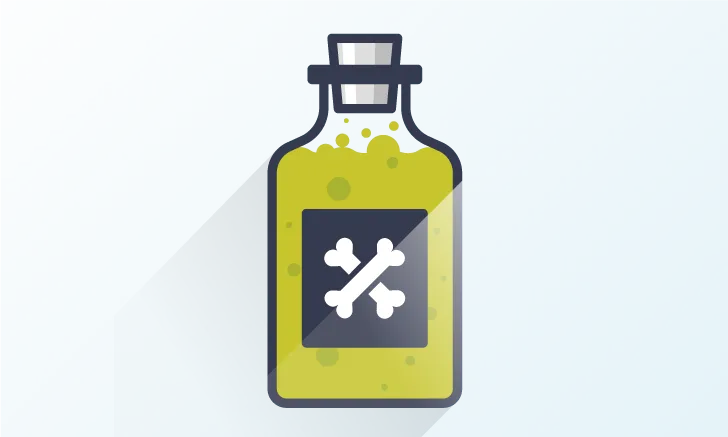Top 5 Toxin Antidote Myths
Tina Wismer, DVM, MS, DABVT, DABT, ASPCA Animal Poison Control Center, Champaign, Illinois

Veterinary professionals often hear from clients who believe myths or old wives’ tales about their pet (eg, I know he is sick because his nose is warm; Chocolate gives dogs worms). Some myths have partial basis in fact, whereas others have none. The internet promotes modern myths, and clients often turn to the internet for advice when their pet needs veterinary attention or suffers a medical emergency such as poisoning. Pet owners may have difficulty separating truth from fiction, and many suggested antidotes are themselves myths and may do more damage than good. Veterinary professionals should also know that a universal antidote does not exist and be prepared to educate clients accordingly.
Following are 5 common toxin antidote myths.
1. Milk
Milk has some efficacy in treating specific toxicoses and is recommended for diluting caustics and irritants (eg, acids, alkalis, detergents) that have been ingested1; however, large volumes of milk can cause vomiting and diarrhea, and many toxicologists recommend a specific amount of milk, or water rather than milk, to avoid these adverse effects.
Milk can also reduce the oral pain seen with ingestion of plants containing insoluble calcium oxalate crystals. The calcium in milk may decrease the absorption of certain pharmaceuticals (eg, bisphosphonates, tetracyclines).2,3
2. Atropine
Atropine is antidotal for treating muscarinic signs (ie, salivation, lacrimation, urination, dyspnea, diarrhea, emesis) caused by organophosphates (OPs) and carbamates.1 Most insecticides were OPs or carbamates years ago, but they have been replaced by pyrethrins or other less toxic chemicals. The EPA did not allow reregistration of these products, and they are therefore no longer available, so the incidence of pets exposed to OPs and carbamates has dropped.
Atropine has no antidotal properties for any other toxins.
3. Burnt Toast & Weak Tea
Burnt toast and weak tea are ineffective antidotes for toxicosis treatment. Whereas activated charcoal is used to treat some toxicoses, burnt bread sections do not function similarly as adsorbents.4 Tea does contain tannins, which historically have been used to treat grayanotoxin plant (eg, rhododendron, azalea) exposure.5 The tannins are thought to slow down the GI absorption of the toxin. Some teas also contain caffeine and have been used as stimulants to counteract sedatives.6 Fortunately, better pharmaceuticals are now available to treat cardiotoxic (including grayanotoxin) plant toxicoses that affect sodium channels and slow the heart rate, potentially causing asystole.
4. Activated Charcoal
Activated charcoal, which is coconut fiber or wood pulp processed under high heat and pressure to create molecules with large surface areas, is antidotal in some cases.4,7 Activated charcoal adsorbs many chemicals and drugs via ion–ion interaction, hydrogen bonding, or dipole or weak van der Waals forces, which reduces the absorption of toxins from the GI tract.8 Toxins are then excreted in the stool, which limits systemic effects and can be potentially life-saving. Because activated charcoal binds with weak chemical bonds, the bonds are reversible. The toxin is at risk of being released back into the GI tract and absorbed, so activated charcoal is often administered with a cathartic to hasten its exit from the body and minimize the chance of systemic absorption.
Activated charcoal binds well to large organic substances but not to other compound types, including most heavy metals, alcohols (ie, ethanol, methanol), fluoride, nitrates, nitrites, caustics, petroleum distillates, sodium chloride, and chlorates.1,7
Although activated charcoal has efficacy against some toxins, activated charcoal administration still has its risks, including1:
Obscuring visualization of GI lesions during endoscopy
Aspiration that can lead to pneumonitis and/or aspiration pneumonia if a patient vomits after administration; activated charcoal therefore should not be administered to a patient that cannot protect its own airway unless intubated with a cuffed endotracheal tube
Hypernatremia, which can occur after activated charcoal administration because of the osmotic pull on free water into the GI tract1
Always weigh the risks and benefits of activated charcoal administration.
5. “Any Antidote Will Do”
Many clients will demand an antidote for their poisoned pet: All I want is the antidote. Unfortunately, most toxins do not have antidotes.1 In cases for which toxin antidotes are available, they may be too expensive or unavailable for veterinary use. Antidotes themselves are also not benign and may have adverse effects (eg, most metal chelators are nephrotoxic).
Timing Is Important
The timing of presentation to the veterinarian is an important factor in case management. With early presentation, emesis may be induced in some cases to reduce the amount of toxins the patient has ingested. Patients must be stabilized before any other therapies—antidotal or otherwise—are given. The antidote, or activated charcoal if efficacious against the ingested toxin, can be administered in appropriate, stable cases to reduce the risks involved with toxicosis.
Poisons, Myths, & Real Antidotes
*The 5 most common toxins reported to the ASPCA Animal Poison Control Center in 2016.
Conclusion
In most cases of potentially poisoned patients, treatment is symptomatic and supportive.1 Fluid therapy may be indicated for cardiovascular or renal support, and GI protectants may be used to treat GI ulcers. Patients should be closely monitored to prevent further problems. Laboratory monitoring can help determine if any organ systems have been affected. (See Poisons, Myths, & Real Antidotes, above.) When managing cases of potentially poisoned pets, the veterinarian should remember to treat the patient, not the poison. Consulting an animal poison control center or veterinary toxicologist for the most up-to-date and tailored treatment advice is always recommended. (See Resources.)